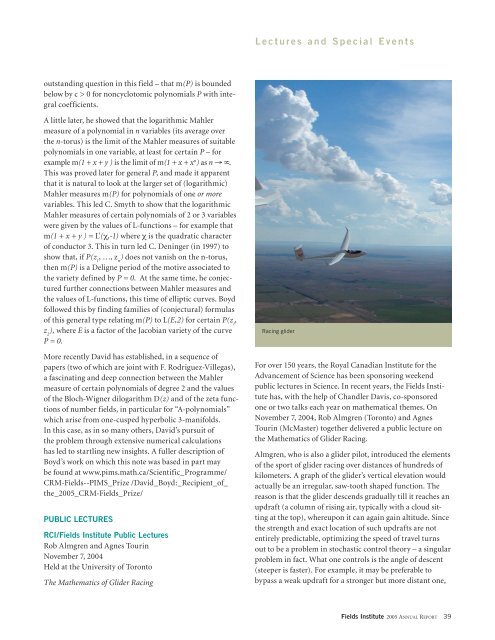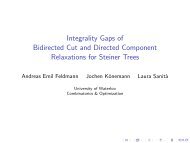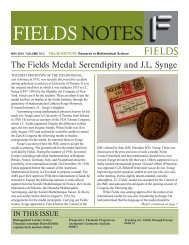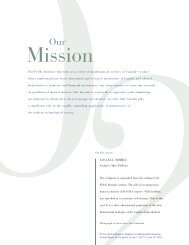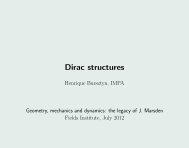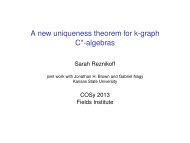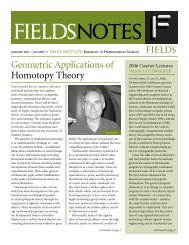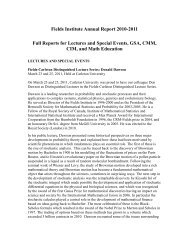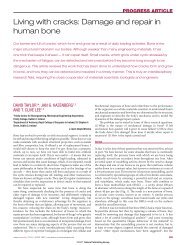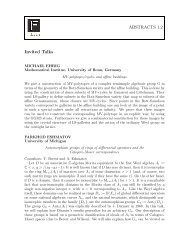Annual Report 2005 - Fields Institute - University of Toronto
Annual Report 2005 - Fields Institute - University of Toronto
Annual Report 2005 - Fields Institute - University of Toronto
Create successful ePaper yourself
Turn your PDF publications into a flip-book with our unique Google optimized e-Paper software.
outstanding question in this field – that m(P) is bounded<br />
below by c > 0 for noncyclotomic polynomials P with integral<br />
coefficients.<br />
A little later, he showed that the logarithmic Mahler<br />
measure <strong>of</strong> a polynomial in n variables (its average over<br />
the n-torus) is the limit <strong>of</strong> the Mahler measures <strong>of</strong> suitable<br />
polynomials in one variable, at least for certain P – for<br />
example m(1 + x + y ) is the limit <strong>of</strong> m(1 + x + x n ) as n → ∞.<br />
This was proved later for general P, and made it apparent<br />
that it is natural to look at the larger set <strong>of</strong> (logarithmic)<br />
Mahler measures m(P) for polynomials <strong>of</strong> one or more<br />
variables. This led C. Smyth to show that the logarithmic<br />
Mahler measures <strong>of</strong> certain polynomials <strong>of</strong> 2 or 3 variables<br />
were given by the values <strong>of</strong> L-functions – for example that<br />
m(1 + x + y ) = L'(χ,-1) where χ is the quadratic character<br />
<strong>of</strong> conductor 3. This in turn led C. Deninger (in 1997) to<br />
show that, if P(z 1 , …, z n ) does not vanish on the n-torus,<br />
then m(P) is a Deligne period <strong>of</strong> the motive associated to<br />
the variety defined by P = 0. At the same time, he conjectured<br />
further connections between Mahler measures and<br />
the values <strong>of</strong> L-functions, this time <strong>of</strong> elliptic curves. Boyd<br />
followed this by finding families <strong>of</strong> (conjectural) formulas<br />
<strong>of</strong> this general type relating m(P) to L(E,2) for certain P(z 1 ,<br />
z 2 ), where E is a factor <strong>of</strong> the Jacobian variety <strong>of</strong> the curve<br />
P = 0.<br />
More recently David has established, in a sequence <strong>of</strong><br />
papers (two <strong>of</strong> which are joint with F. Rodriguez-Villegas),<br />
a fascinating and deep connection between the Mahler<br />
measure <strong>of</strong> certain polynomials <strong>of</strong> degree 2 and the values<br />
<strong>of</strong> the Bloch-Wigner dilogarithm D(z) and <strong>of</strong> the zeta functions<br />
<strong>of</strong> number fields, in particular for “A-polynomials”<br />
which arise from one-cusped hyperbolic 3-manifolds.<br />
In this case, as in so many others, David’s pursuit <strong>of</strong><br />
the problem through extensive numerical calculations<br />
has led to startling new insights. A fuller description <strong>of</strong><br />
Boyd’s work on which this note was based in part may<br />
be found at www.pims.math.ca/Scientific_Programme/<br />
CRM-<strong>Fields</strong>--PIMS_Prize /David_Boyd:_Recipient_<strong>of</strong>_<br />
the_<strong>2005</strong>_CRM-<strong>Fields</strong>_Prize/<br />
PUBLIC LECTURES<br />
RCI/<strong>Fields</strong> <strong>Institute</strong> Public Lectures<br />
Rob Almgren and Agnes Tourin<br />
November 7, 2004<br />
Held at the <strong>University</strong> <strong>of</strong> <strong>Toronto</strong><br />
The Mathematics <strong>of</strong> Glider Racing<br />
L e c t u r e s a n d S p e c i a l E v e n t s<br />
Racing glider<br />
For over 150 years, the Royal Canadian <strong>Institute</strong> for the<br />
Advancement <strong>of</strong> Science has been sponsoring weekend<br />
public lectures in Science. In recent years, the <strong>Fields</strong> <strong>Institute</strong><br />
has, with the help <strong>of</strong> Chandler Davis, co-sponsored<br />
one or two talks each year on mathematical themes. On<br />
November 7, 2004, Rob Almgren (<strong>Toronto</strong>) and Agnes<br />
Tourin (McMaster) together delivered a public lecture on<br />
the Mathematics <strong>of</strong> Glider Racing.<br />
Almgren, who is also a glider pilot, introduced the elements<br />
<strong>of</strong> the sport <strong>of</strong> glider racing over distances <strong>of</strong> hundreds <strong>of</strong><br />
kilometers. A graph <strong>of</strong> the glider’s vertical elevation would<br />
actually be an irregular, saw-tooth shaped function. The<br />
reason is that the glider descends gradually till it reaches an<br />
updraft (a column <strong>of</strong> rising air, typically with a cloud sitting<br />
at the top), whereupon it can again gain altitude. Since<br />
the strength and exact location <strong>of</strong> such updrafts are not<br />
entirely predictable, optimizing the speed <strong>of</strong> travel turns<br />
out to be a problem in stochastic control theory – a singular<br />
problem in fact. What one controls is the angle <strong>of</strong> descent<br />
(steeper is faster). For example, it may be preferable to<br />
bypass a weak updraft for a stronger but more distant one,<br />
<strong>Fields</strong> <strong>Institute</strong> <strong>2005</strong> ANNUAL REPORT 39


